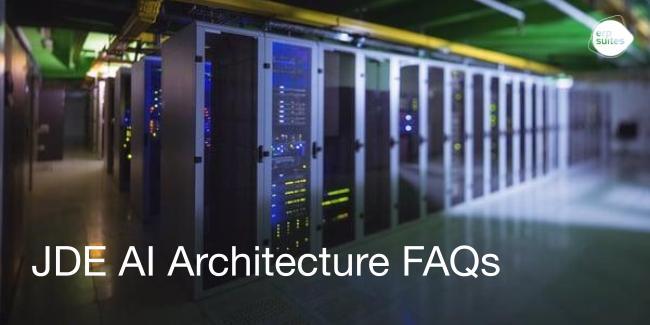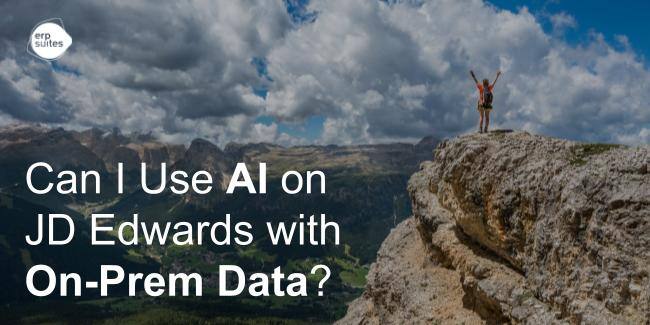4 Elements of a JD Edwards Tech Refresh and Cost Considerations
November 6th, 2023
6 min read

As time marches on, so does technology. iOS versions are updated on an ongoing basis, Windows is updated on an ongoing basis. Every year a new version of any given operating system is available. That external technology evolves in response to the world around us, and the varying needs and desires for technology in general. It is also still required for a JD Edwards application, but the requirements to use those operating systems and that technical foundation begins to move as well. JD Edwards can’t run on just any version of DOS – it requires a specific operating level. As the operating systems behave differently, they must be adopted for JD Edwards to continue to function.
This article will go over the basics of a tech refresh, what that process entails, and key considerations you’ll want to keep in mind when undergoing a tech refresh.
What is a tech refresh?
If a tools refresh is the technical foundation of JD Edwards, addressing not the functional code but the underlying code that is common to all its functional applications, a “tech refresh” is a layer lower than that still. Tech refresh is not a term that Oracle or JD Edwards coined; it’s a term ERP administrators use for refreshing the technical infrastructure that the application of JD Edwards sits on top of and runs on. That technical infrastructure includes things like the operating systems, the databases and their versions, and the middleware or web server versions.
A tech refresh takes a look at the technology you’re running on and makes an assessment about what needs to be updated and what should be updated, enabling your team to make a plan that addresses those components. Middleware may also and often does include the Tools Release for JD Edwards itself. So, while you’re under the hood, why not fix it and get up to date on the JD Edwards tools as well?
Staying tech-current within an ERP
JD Edwards is a business system within the family of enterprise resource planning systems. ERPs are business systems built around the idea that everything you do in business has a money component to it, so all of those business systems tie back to its core financials. In this world where best of breed approaches and roll-your-own integrations are being implemented, JD Edwards has had to evolve to allow integrations, for instance, of external systems into JD Edwards. You can take your favorite system from an HR standpoint, for example, implement and integrate that, and pull data out of it as needed to push it into your payroll system, for instance. The advantage is that you’re keeping your legacy preferred program and are still able to integrate into JD Edwards – essentially achieving the best of both worlds.
JD Edwards does not demand exclusive control of that environment; rather, it allows, accepts, and facilitates integration with other best-of-breed business systems as you choose, and continues to evolve as technology outside of JDE evolves. JDE continues to be a growing and vibrant system, changing as change is required. It’s not static or stuck in the past.
Why you need periodic tech refreshes within JDE
Let’s use Automatic Data Processing, or ADP, as an example. This HR and payroll system is well known and well regarded in the business world. You can integrate ADP into JD Edwards using technology JDE has evolved and developed into its product – specifically, orchestrations. JD Edwards has evolved in order to remain viable as the center of your business system universe by allowing integrations and enhancing its capacity to allow integrations.
Because ADP is an application that exists outside of JD Edwards, it has certain protocol requirements and encryption requirements to interoperate with other applications. ADP expects that its data is sent with a certain packet size and a certain encryption algorithm. In order to meet those requirements and for your JD Edwards integration to ADP to work, you need to be able to produce that content and encryption, which necessitates compatibility within your tools release code, as well as your operating system and network requirements.
So when ADP says, you have to use the latest and greatest encryption algorithm and you’re on an OS or Tools Release that does not support that, or perhaps you’re on a Tools Release that does but the OS doesn’t, you’re stuck in a position where you’re forced to change you’re underlying OS or tools release in order to meet the requirements of that integration.
The world outside of your core JD Edwards system changes and tech refreshes need to be implemented in order for you to meet those requirements of the world outside of your control.
Four Elements of a Tech Refresh
To get the tech refresh process rolling, you need to consider several key points to conduct a comprehensive assessment of your existing JD Edwards environment. This includes evaluating your software, hardware, and infrastructure components. Other points to consider are your current risks, and current limitations in that environment.
Current operating system
A tech refresh could also include re-platforming from one operating system or platform to another. Some customers might want to move from something like IBMi to Linux in order to take advantage of capabilities and future direction potential and different feature functionality. Price is also a consideration – the expense of running on one platform versus another is not a small consideration.
Software and hardware upgrades
If you’re already going to have to do a tech refresh, you might want to consider whether this is a good time to also include a tools refresh. You will be testing anyway, and putting together a project, so it’s a good idea to take additional time to see if you can kill two birds with one stone.
Today most hardware we think of as machines are actually virtual, that sit on top of a shared hardware platform. The tech refresh isn’t really an inflection point where the physical hardware is changed out, unless you’re running on a physical hardware platform. Most platforms are virtualized though, so what you’ll be thinking about then is whether or not the operating system or virtual drivers or hypervisor (virtualization software itself) layer need to be upgraded.
Hardware infrastructure enhancement
As mentioned above, your infrastructure might need an overhaul, too. This could include replacing outdated servers, storage systems or networking equipment to improve performance, scalability, and reliability. Upgrading your hardware can support the increased processing demands of the latest JD Edwards software versions, leading to optimal system performance.
Data migration and integration
A tech refresh could mean a different database version, or a new database server is required. If you are not choosing re-platforming, but have an old version of a database, you need to get to a new version because of vulnerabilities and limitations that exist in that older version. The primary platform for integration with JD Edwards is orchestrations. There are limitless ways of integration thanks to this tool.
In-place upgrade
You might select to do an in-place upgrade, but in most cases, DBAs do not recommend this route. It adds risk to the project that can be avoided if you instead do a migration to a new database server. If this route is taken, you would need to first execute a full backup of that database server so that if something went wrong in the process, it could be restored. However, sometimes backups go well but restores don’t, so another pitfall of doing an in-place upgrade is that associated risk.
New server
Migrating to a new database server is a time-consuming process but you can leave the existing database server up and running and essentially pump the data from one to the other. At the end of the day, if you have a failure in the process, you have a way back – you just use the old database server, without degrading it in the migration. Restated, if a connection is lost or a server failure occurs, the data migration could fail, but again, that is easily overcome, as you can just revert to the old machine.
ERP Suites DBAs tend to recommend this process, especially as virtual servers are primarily being used. This is a cost-saving measure, as it eliminates the need for purchasing additional hardware, expanded electricity capacity needs and physical location requirements.
In the end, when considering which method to choose, you need to think not only about how it might lead to success, but also about how it might lead to failure, and if so, how can you make sure that if the process fails, your business remains in a viable state.
Compliance requirements
Compliance requirements can encompass reporting, calculation, and security. Your industry might have specific requirements regarding security that you need to ensure your tech refresh remains in compliance with. There are income tax requirements associated with the municipality or municipalities you conduct your business within, so it’s important to keep up to date with the tax tables that your vendors maintain that are integrated with JD Edwards.
Within certain industries, there may be very tight controls on your data, so you may need to maintain certain security levels on that data. So, if you make a backup or migrate data, you’ll need two sets of that data to maintain compliance.
Cost Considerations and ROI
There is an array of cost factors to consider. These could include hardware, licensing, or support. More likely, in a virtual environment, the largest costs will be associated with labor. There are project management resources, technical resources, business processes, and necessary SMEs for integration platforms that will all incur varying costs. You’ll need to analyze these involved costs at the outset of your tech refresh process, especially as pertains to labor costs.
What drives thoughts around investment isn’t necessarily the return on that investment, but lost opportunity cost that can be avoided. If you don’t stay within striking distance of tomorrow’s requirements for tomorrow’s technology by not adopting tech refreshes as necessary, you’re going to miss out on your competitors in your industry who are already operating more closely with that technology. These competitors will be early adopters and you may find yourself out of the game, or in a vulnerable state from a security standpoint. You want to position yourself moving forward rather than stuck in the past.
How to measure the success of a tech refresh project
At the beginning of the whole process, you made your assessment of all your key considerations and desired outcomes. You’ll want to now assess whether you ultimately achieved all those desired outcomes. Did you put yourself in a position to take advantage of or address those exposures that were identified? That’s the largest measure in action by far. There are smaller measures of success, too. Did you meet desired timeframes and downtime targets? Within your testing and your quality assurance, there are validation and testing measures, too. Does everything work in terms of executing your critical business functions? For the new functions that were implemented, has performance now improved?
Making your tech refresh move
At the end of the day, a tech refresh is an investment in the continued health and success not only of your JD Edwards system, but also of your company itself. If you want to start the process, ERP Suites is ready and able to help. You can reach our team of experts here.
Leyla Shokoohe is an award-winning journalist with over a decade of experience, specializing in workplace and journalistic storytelling and marketing. As content manager at ERP Suites, she writes articles that help customers understand every step of their individual ERP journey.
Topics:



.png?width=650&height=325&name=Blog%20Images%202_1%20(4).png)
.png?width=650&height=325&name=Blog%20Images%202_1%20(5).png)
.png?width=650&height=325&name=Blog%20Images%202_1%20(3).png)
.png?width=650&height=325&name=Blog%20Images%202_1%20(2).png)
.png?width=650&height=325&name=Blog%20Images%202_1%20(1).png)
.png?width=960&height=540&name=Blog%20Images%20(96).png)

.png?width=960&height=540&name=Blog%20Images%20(90).png)
.png?width=960&height=540&name=Blog%20Images%20(88).png)
.png?width=960&height=540&name=Blog%20Images%20(87).png)
.png?width=960&height=540&name=Blog%20Images%20(86).png)
.png?width=960&height=540&name=Blog%20Images%20(85).png)
.png?width=960&height=540&name=Blog%20Images%20(83).png)
.png?width=960&height=540&name=Blog%20Images%20(82).png)
.png?width=960&height=540&name=Blog%20Images%20(80).png)